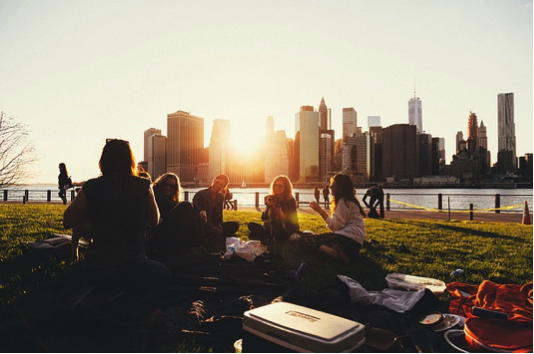Splash Through Summer with Peaches
Sweet and juicy peaches are one of North Carolina’s finest summer time fruits. Though they are available year round, they taste best and are less expensive during the summer. In our state, the peach industry is unique because it sells 90 percent of its crop on the fresh market, directly to the consumer, just days after being picked off the tree.
In 2014, North Carolina produced 4,380 tons of peaches (1,100 acres grown) totaling $6.2 million in value to the state’s economy. While our state may not the biggest grower, it is surely one of the best. (source: NC Department of Agriculture and Consumer Sciences)
NC peaches are available from the end of May through August. They can be found at roadside stands, farmers markets and retail outlets.
Besides their great taste, peaches are full of vitamins and minerals, including vitamin A, vitamin C, riboflavin and beta-carotene. Peaches are also low in calories, fat free, sodium free and cholesterol free. One medium peach contains the following nutritional value:
| Calories | 40 |
| Protein | 0.6g |
| Carbohydrates | 10g |
| Fat | 0g |
| Cholesterol | 0mg |
| Sodium | 0mg |
| Dietary Fiber | 1.5g |
| Vitamin A | 47RE |
Peaches can be eaten fresh in salads and smoothies, as a topping for yogurt, ice cream, cereal, pancakes, or waffles, and as a filling for pies, tarts, cobblers, or strudels. They can also be grilled and served as a unique side dish with meat, fish or poultry. Peaches are also available dried, frozen, canned, and as nectar, jam or jelly.
For best quality, select peaches that are firm to slightly soft and free from bruises. The best sign of ripeness in a peach is a creamy or golden undertone, often called “ground color.” The rosy “blush” on a peach is not a good indicator of ripeness and differs from one variety to another. Fresh peach fragrance also indicates ripeness. Avoid peaches with a green ground color as they lack flavor and usually shrivel and become tough rather than ripen. Peaches that are picked green may develop more juice, but they will not become sweeter. When selecting canned peaches look for those that are labeled “packed in its own juice,” “lite,” or “no sugar added.” These are healthier choices.
When cleaning and preparing peaches, wash them by rubbing them gently under running water. If a recipe calls for peeled peaches, dip peaches into boiling water for about 30 seconds, then plunge them immediately into iced water. The skins will slip right off.
Fresh peaches darken quickly when exposed to air. Prevent browning of fresh cut peaches by dipping fruit into a mixture of 1 cup water and 1 tablespoon lemon juice. A commercial ascorbic acid mixture like Fruit Fresh can also be used to prevent browning. Store fully ripe peaches in the refrigerator, and for the best peachy taste, serve ripe peaches at room temperature. The next time you’re in the mood for a healthy and delicious fruit, grab a peach! Summer just wouldn’t be the same without the sweet taste of North Carolina peaches.
Try this easy and delicious peach recipe:
Peach Splash
Yield: 4 servings
- 1½ cups peaches peeled and sliced or 1½ cups
- frozen peach slices
- 2 tablespoons sugar
- ¼ teaspoon nutmeg or cinnamon
- 2 cups milk
- 8-10 ice cubes (omit ice is using frozen peaches)
- Combine all ingredients in a blender and mix well.
- Gradually add ice cubes and mix until finely
- crushed. Garnish with a dash of nutmeg.
Sources: Food Sense, Utah State University Cooperative Extension and North Carolina Department of Agriculture and Community Science
Stephanie
Healthy pizza? Read below …

If you asked my family what their favorite food is, they would say “pizza!” As a mom, I worried about feeding pizza to my children, because what you buy is typically in high in fat. Most restaurants do not offer a whole-grain or whole-wheat curst either. So, how can you feed your family one of their favorites and still have it be healthy?
Let’s start with the crust. Did you ever think about using a whole-wheat English muffin, tortilla, or a rice cake instead of the traditional pizza crust? Whole grains and whole wheat provide fiber, in addition to being very tasty. You can also be adventurous and make a crust from cauliflower, which is also quite delicious.
Do you have to skip the cheese? No. You can use a low-fat version of Mozzarella, Provolone, or even Cheddar, and still get your calcium. Remember, a low-fat cheese still has calories, so don’t overdo it.
Vegetables and fruits make for great toppings for pizzas. How about trying green/red/ yellow peppers, onions, fresh tomatoes, mushrooms, spinach, corn, kale, black beans, or avocado? If you are using fresh vegetables, you may want to cook the vegetable beforehand to soften it. If using frozen vegetables, you will want to thaw and squeeze out the moisture to avoid a soggy crust. Pineapple, apple, mango, strawberries, blueberries, oranges and peaches are also great additions to a pizza. Ask your family to each select a favorite vegetable and/or fruit to add for a topping to your next homemade pizza.
You can still add meat to your pizza. Just change the kind of meat options you are using and even use less of them. Instead of ground beef, use ground turkey. Replace sausage and bacon with shredded chicken. The pepperoni can stay, but opt for a turkey pepperoni instead. Scrambled eggs are a tasty topping too!
Trying all or some of these tips will help you feed your family a healthier pizza. You might find that making a pizza from scratch costs less money than buying one at a store or restaurant. Why not have pizza night at your house and get the whole family involved?
Judy
Safe food, safe time this holiday season

It’s that time of year again! Family and friends get together to enjoy food outside during picnics and cook outs. These events are a great way to spend quality time while enjoying the outdoors and nature. It’s important to have fun, but keeping your food safe by storing and handling it properly is critical while going on a picnic or cook out.
Foods from a refrigerator need to be kept cold, so storing these products in a cooler filled with ice should be prepared prior to going out in the summer heat. Also, organizing what is in the cooler should be considered so that everything stays cold and safe from growth of bacteria. We want to keep our friends and family safe while eating good food!
In addition, cleaning everyone’s hands is a must before handling food products. Germs can be harmful if ingested and can cause illness. If there is no clean running water available, gather a jug and some soap. Moist antibacterial towels can also be used to clean the hands before eating.
This summer, enjoy each other’s company while soaking up the sun. Now is a great time for a picnic!
For more information about picnic safety, refer to the link: http://www.fda.gov/Food/ResourcesForYou/Consumers/ucm109899.htm
Have fun this summer!
Susan
Keep them playing, keep them safe

I distinctly remember falling off a scooter as a child and scraping my knees on the hot concrete. They took a couple of weeks to heal, but the injury could have been prevented if I had been wearing knee pads. While it may seem like wearing extra equipment or following certain rules takes too much time, it’s critical to preventing both minor and major accidents–trust me, I’ve been there!
Here are some tips you can follow to keep your kids safe while they play:
- General Tip: Never leave them alone outside. Staying with your kids while they play is a great way to spend time together while keeping an eye on their environment to keep them safe!
- Setting Up a Safe Environment: Playgrounds and other outdoor play areas may have gas grills, electrical appliances, or other hazardous items. Keep kids away from such equipment, and direct them towards safe activities and toys.
- Riding Toys: Always require children to wear properly fitted helmets when riding bikes or other riding toys. I’m obviously an advocate for knee pads and elbow pads for extra protection.
- On the Playground: Playground equipment can get very hot in the summer heat. Test the playground equipment before allowing your children to play on it, and provide a shaded area near the playground to rest and rehydrate.
Don’t forget to talk to your kids about why we follow these rules–they’re not to ruin their fun, but to keep them from hurting themselves (because bruises and scraped knees are NOT fun)!
To this day I’m uneasy about riding scooters–following safety tips such as these for your children can prevent accidents like the one I was in and encourage them to try new activities and Move More!
Cara
Buy local, eat local at the farmers' market
 Over the years, local Farmer’s Markets have become increasingly popular. They are great sources for purchasing fresh fruits, vegetables and other food items such as homemade jams, etc.
Over the years, local Farmer’s Markets have become increasingly popular. They are great sources for purchasing fresh fruits, vegetables and other food items such as homemade jams, etc.
Depending on where you live (rural or urban town/city), farmer’s markets vary in size, location, times in which they are open and products sold. Some are very small while others are huge. Both offer the opportunity for consumers to purchase freshly grown food items from local farmers. What a great concept!
So, you may ask yourself, why should I shop at a local farmer’s market. There are many different reasons to shop at your local farmer’s market. Here are a few:
- Buying from a local farmer supports local agriculture. This means that the foods we eat come from nearby, and does not require us to waste lots of energy and petroleum to ship the food halfway around the world.
- You can find a variety of fresh, organic produce at more affordable prices than in a supermarket. Many farmers carry products that are not technically “organic,” but have many low-priced foods that are pesticide and herbicide free. The advantage at a farmers market is that you can actually talk to the farmer, learn about their methods, and then decide for yourself.
- Buying locally also means that you are supporting farmers and the local economy. Not only will your money stay in your area, but you will happily please the farmer that worked to grow the food.
- The food from your local farmers market is fresher. Because it was grown locally, there is a good chance that the apple you buy from the farmer was picked a few days ago. This is virtually impossible in a big supermarket.
- There is usually an amazing variety of fruits and veggies at your local farmers market. Each farmer may have his own method for growing tomatoes or peppers. This is something that never happens at a grocery store.
- There is no doubt that locally-grown foods just simply tastes better. You will never be able to eat a carrot from the grocery store again!
- There’s just no way around it, eating fresh, locally-grown fruits and veggies are great for your health.
- Lastly, farmer’s markets are just plain fun for the entire family. Meeting your local community is an excellent way to feel connected to the world around you.
For more information on farmer’s markets and other local food topics, go to the following link: https://localfood.ces.ncsu.edu/
Stephanie